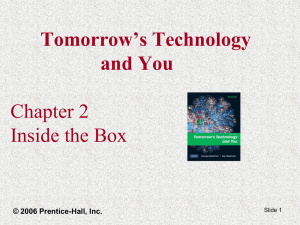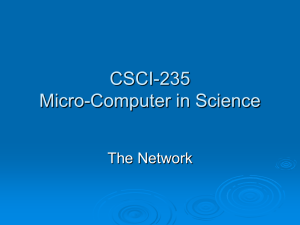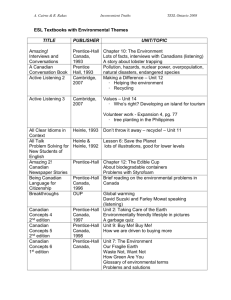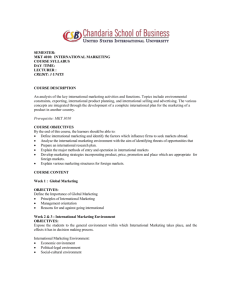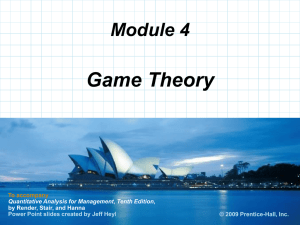Marketers
advertisement
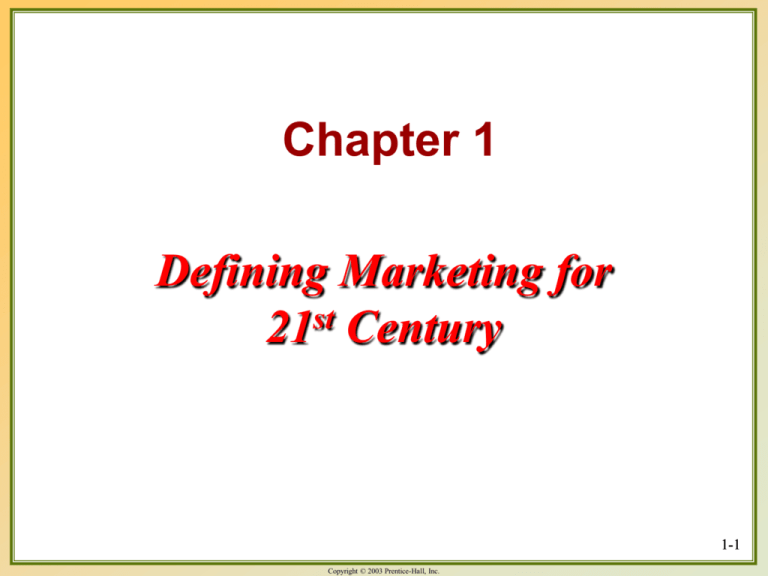
Chapter 1 Defining Marketing for st 21 Century 1-1 Copyright © 2003 Prentice-Hall, Inc. Key Points for Chapter 1 1. 2. 3. 4. 5. 6. 7. 8. Definition of marketing Demand States Marketplace, marketspace and metamarket Needs, wants, and demands Value and satisfaction Customer value triad Marketing channels Supply chain 1-2 Copyright © 2003 Prentice-Hall, Inc. Key Points for Chapter 1 9. Production concept, product concept, selling concept, and marketing concept 10. Relationship marketing 11. Integrated Marketing 12. Four P’s and Four C’s 13. Internal marketing and external marketing 14. Societal responsibility marketing 15. Market Segmentation, Targeting, and Positioning 1-3 Copyright © 2003 Prentice-Hall, Inc. The Importance of Marketing Financial success depends on marketing ability All other company functions will not matter, if there is not sufficient demand for its products and services which brings a profit to a company. 1-4 Copyright © 2003 Prentice-Hall, Inc. The Scope of Marketing What is Marketing? What is Marketed? Who Markets? Marketing in Practice 1-5 Copyright © 2003 Prentice-Hall, Inc. What is Marketing? Marketing Marketing is about identifying and meeting human and social needs. In short, marketing is “meeting needs profitably.” Social Definition of Marketing: Marketing is a societal process by which people obtain what they need and want through creating, offering, and exchanging products and services of value with others 1-6 Copyright © 2003 Prentice-Hall, Inc. What is Marketed? 10 Types of Marketing Entities 1. Goods 2. Services 3. Experiences 4. Events 5. Persons 6. Places 7. Properties 8. Organizations 9. Information 10. Ideas 1-7 Copyright © 2003 Prentice-Hall, Inc. Who Markets? Marketers and Prospects Marketers Prospects Eight demand states Negative demand, Latent demand, Irregular demand, Overfull demand, Nonexistent demand Declining demand Full demand Unwholesome demand 1-8 Copyright © 2003 Prentice-Hall, Inc. Who Markets? Markets Traditional concept Economist’s concept Marketer’s concept 1-9 Copyright © 2003 Prentice-Hall, Inc. Who Markets? Five Basic Markets & Connecting Flow (Fig. 1.1) 1. Resource markets 2. Manufacturer markets 3. Intermediary markets 4. Government markets 5. Consumer markets 1-10 Copyright © 2003 Prentice-Hall, Inc. Relationship between Industry and Market (Fig. 1.2) 1-11 Copyright © 2003 Prentice-Hall, Inc. Who Markets? Key Customer Markets Consumer markets Business markets Global markets Nonprofit & Government market Marketplace, Marketspace, and Metamarkets Marketplace Marketspace Metamarket 1-12 Copyright © 2003 Prentice-Hall, Inc. Marketing in Practice Marketing is not done only by marketing department Five Functions of CMO 1. Strengthening the brands 2. Measuring marketing effectiveness 3. Driving new product development based on customer needs 4. Gathering meaningful customer insights 5. Utilizing new marketing technology 1-13 Copyright © 2003 Prentice-Hall, Inc. Core Marketing Concepts Needs, Wants, and Demands Needs: Basic human requirements Wants: Specific objects that might satisfy needs Demands: Wants backed by an ability to pay Criticism: Five types of needs Stated needs Real needs Unstated needs Delight needs Secret needs 1-14 Copyright © 2003 Prentice-Hall, Inc. Core Marketing Concepts Market Segmentation, Targeting, and Positioning Market segmentation Market targeting Market positioning Value Proposition, Offerings, and Brands Value proposition Market offering Brand 1-15 Copyright © 2003 Prentice-Hall, Inc. Core Marketing Concepts Value and Satisfaction Customer value triad: Quality, Service, & Price Degree of Satisfaction Disappointed Satisfied Delighted Marketing Channels Communication channels Distribution channels Service channels 1-16 Copyright © 2003 Prentice-Hall, Inc. Core Marketing Concepts Supply Chain From raw materials to components to final goods to final buyers Upstream and downstream of a value-delivery network Competition Include all the actual and potential rival offerings and substitutes that can satisfy the same customer needs or wants Do not fall into the “Marketing Myopia” 1-17 Copyright © 2003 Prentice-Hall, Inc. Core Marketing Concepts Marketing Environment Task Environment: Microenvironment The company, suppliers, distributors, dealers, and customers Broad Environment: Macroenvironment Demographic, Economic, Techological, Political-Legal, & Social-Cultural Environments 1-18 Copyright © 2003 Prentice-Hall, Inc. New Marketing Realities Major Societal Forces New Consumer Capabilities New Company Capabilities 1-19 Copyright © 2003 Prentice-Hall, Inc. Major Societal Forces Network Information Technology Globalization Deregulation Privatization Heightened Competition Industry Conversion Consumer Resistance Retail Transformation Disintermediation 1-20 Copyright © 2003 Prentice-Hall, Inc. New Consumer Capabilities A substantial increase in buying power A great variety of available goods and services A great amount of information about practically anything A great ease in interacting and placing and receiving orders An ability to compare notes on products and services An amplified voice to influence peer and public opinion 1-21 Copyright © 2003 Prentice-Hall, Inc. New Company Capabilities Can use the Internet as a powerful information and sales channel and reach customers worldwide Can collect fuller and richer information about markets, customers, prospects, and competitors. Can facilitate and speed internal communication among their employees Can facilitate and speed external communication with customers 1-22 Copyright © 2003 Prentice-Hall, Inc. New Company Capabilities Can have easier target marketing and two-way communication Can assemble information about individual customers’ purchases, preferences, demographics, & profitability Can reach consumers on the move with mobile marketing Can produce individually differentiated products 1-23 Copyright © 2003 Prentice-Hall, Inc. New Company Capabilities Can improve purchasing, recruiting, & training Can achieve substantial savings by using the Internet to compare sellers’ prices and to purchase materials at auction or by posting their own terms Can improve logistics and operations and reap substantial cost savings, at the same time increasing accuracy and service quality. 1-24 Copyright © 2003 Prentice-Hall, Inc. Company Orientations Toward the Market Place The Production Concept The Product Concept The Selling Concept The Marketing Concept The Holistic Marketing Concept 1-25 Copyright © 2003 Prentice-Hall, Inc. The Production Concept It holds that consumers will prefer products that are widely available and inexpensive. High production and distribution efficiency to reduce cost Makes sense in developing countries 1-26 Copyright © 2003 Prentice-Hall, Inc. The Product Concept It holds that consumers favor products that offer the most quality, performance, or innovative features Major focuses on making superior products and improving them over time without realizing what the market needs or wants Better-mousetrap fallacy. WebTV’s early failure 1-27 Copyright © 2003 Prentice-Hall, Inc. The Selling Concept It holds that customers or businesses, if left alone, will ordinarily not buy enough of the company’s products Therefore, the company must undertake aggressive selling and promotion efforts to passive buyers Companies aim to sell what they make rather than make what the market wants. Make-andsell philosophy. Unsought goods and goods that buyers normally do not think of buying Hard selling carries high risk. 1-28 Copyright © 2003 Prentice-Hall, Inc. The Marketing Concept It holds that the seller must first find out what the markets need or want and create, deliver and communicate superior customer value to the chosen target markets. Sense-and-respond philosophy. Starts with target market Finds right products for customers rather than right customers for the firm’s products Gardening instead of hunting Superior concept than selling concept 1-29 Copyright © 2003 Prentice-Hall, Inc. The Marketing Concept (continued) Marketing concept can be applied by Reactive marketing orientation Meet customers’ expressed needs only Proactive marketing orientation Meet customers latent needs through a “probeand learn” process Total marketing orientation Both Reactive and Proactive marketing 1-30 Copyright © 2003 Prentice-Hall, Inc. The Holistic Marketing Concept Relationship Marketing Integrated Marketing Internal Marketing Social Responsibility Marketing 1-31 Copyright © 2003 Prentice-Hall, Inc. Relationship Marketing Building mutually satisfying long-term relationships with Customers under CRM (Customer Relationship Management) for customer retention & a larger share of customer’s wallet. Marketing partners under PRM (Partner Relationship Management) for effective delivery to final customers. Key suppliers & distributors Competition is not between companies but between marketing networks 1-32 Copyright © 2003 Prentice-Hall, Inc. Integrated Marketing All marketing activities and programs need to be integrated Coordinates the seller’s 4 P’s with customer’s 4 C’s Four P’s: Product, Price, Place, Promotion Four C’s: Customer solution, Customer cost, Convenience, Communication 1-33 Copyright © 2003 Prentice-Hall, Inc. Internal Marketing Task of hiring, training, and motivating employees Marketing activities within the company 1-34 Copyright © 2003 Prentice-Hall, Inc. Social Responsibility Marketing Marketing must be conducted in a way that preserves or enhances the consumer’s and society’s well-being. Profit to a company, satisfaction to consumers, and well-being to society Examples McDonald’s (Table 1.2) Ben & Jerry: 7.5% of pretax profit The Body Shop: Trade-Not-Aid program Patagonia:1% of sales or 10% of pretax profit 1-35 Copyright © 2003 Prentice-Hall, Inc. Marketing Management Tasks Developing Marketing Strategies and Plans Capturing Marketing Insights Connecting with Customers Building Strong Brands Shaping the Marketing Offerings Delivering Value Communicating Value Creating Long-Term Growth 1-36 Copyright © 2003 Prentice-Hall, Inc.
